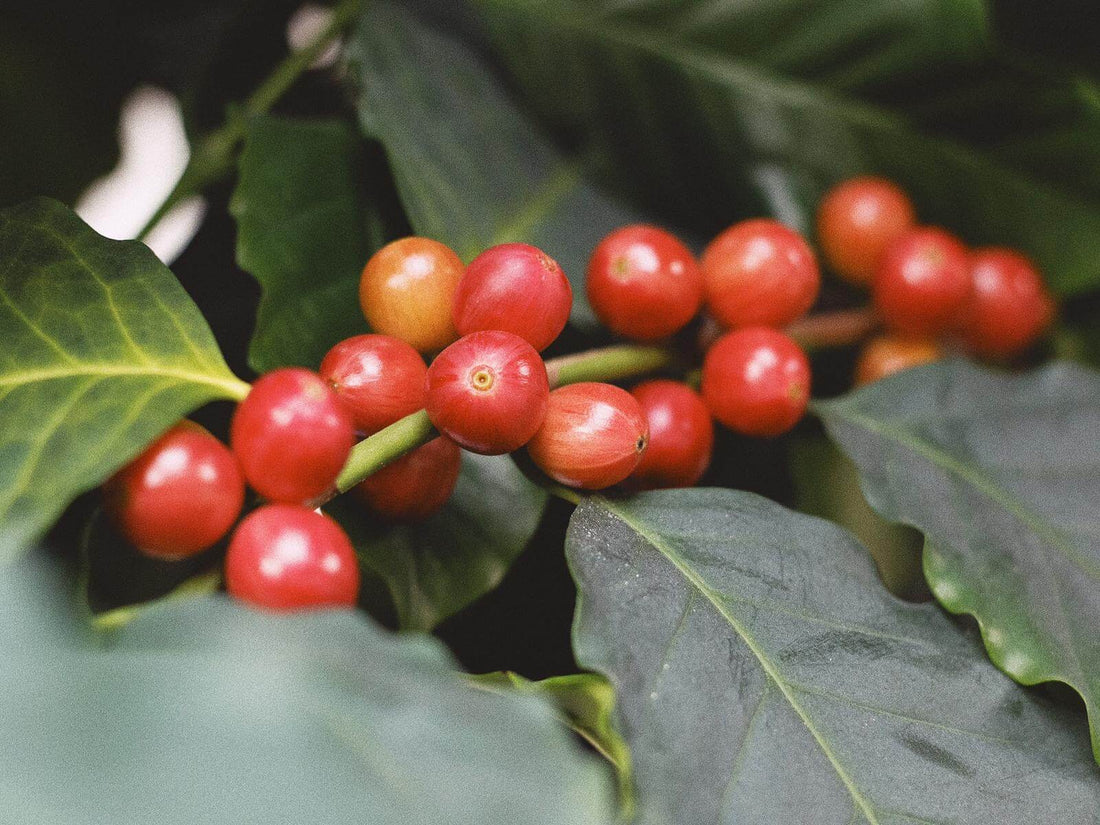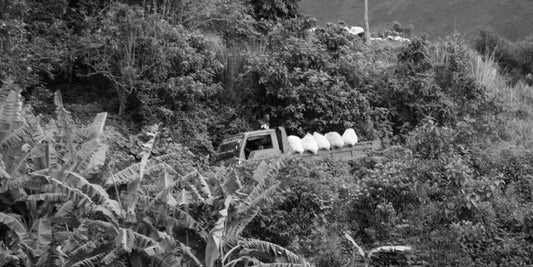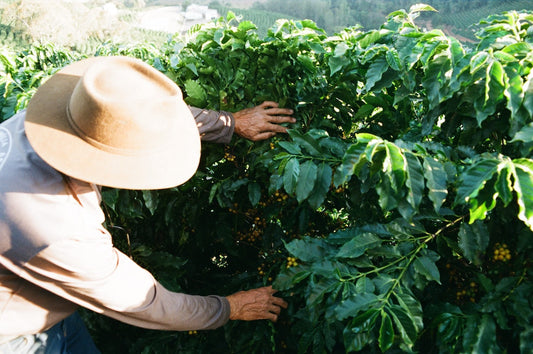
Finca Roastworks Coffee Harvest 2020
*Words in bold are explained in the Glossary at the end of this blog post.
If you’re an avid Roastworks stalker you might have noticed, we have a mature coffee tree in our roastery office. This tree is over 30 years old and was grown from seeds gifted to my parents by an Ethiopian woman back in the 80’s. Whilst I don’t have definitive proof of its variety, I can only presume it’s an heirloom Ethiopian plant, and I’ve always assumed so. It’s been through a lot over the years and for much of its life it hasn’t thrived. Anyone who has grown a coffee plant will know how temperamental they can be, and this is no exception.

It was only around 5 years ago that we decided to really give it some TLC and we quickly reaped the rewards. Almost every year, the branches are adorned by delicate, intoxicating, beautiful flowers (if you’ve never had the pleasure of smelling coffee flowers, imagine orange blossom on steroids) which turn to fruit, and this year has been the most exciting yet. The tree first flowered back in the autumn and has been sitting with green cherries on its branches for most of the winter. Thanks to the heating system in the office the mean daytime temperature throughout winter was a balmy 19 degrees Celsius and the nights never dropped below about 6 degrees. Not too different to coffee growing countries. The problem is that because the tree is inside there’s always a chance that the cherries never ripen, which has happened a couple of times. So, naturally when I saw the cherries starting to turn red back in March, I was VERY excited.
We have now harvested two lots of coffee from this tree and below are details of how we harvested and processed the coffee. We will update this blog post in a few months once the coffee has rested and we’ve had a chance to cup it.
Like all fruit trees, the fruit on a coffee tree ripens at different rates. We decided to go for two harvests as this gave us about a 50/50 yield from each pick and ensured we were picking only ripe cherries. We made the decision to pick fruit of different ripeness for each harvest. So, for the first harvest we picked ripe, but only just ripe cherries, and for the second harvest, which followed about 3 weeks later we let the fruit ripen a little more. We opted for a washed process. Here’s what we did…


HARVEST ONE
• We immersed the cherries in water to check for floaters. No floaters. Good news!We picked around 190gs of cherries.
• Within 1 hour of picking we pulped the cherries and immersed the beans in water (Turns out this was a mistake. More on that later).
• We washed the beans to try and remove the mucilage over the course of 5 hours. We replaced the water several times and agitated the beans occasionally.
• We pressed the juice out of the cherry pulp and all had a little shot. It made us feel a bit funny. I’m aware that the pulp of the coffee cherry is a superfood and is not only packed full of powerful antioxidants and natural sugars, but also caffeine. It also tastes really good. Hard to describe, but the closest match is probably ripe honeydew melon.
• We then took the beans out and laid them on a plate on a single layer in a sunny spot.
• We allowed the beans 14 days to dry, turning occasionally, before removing the hard silver-ish shell, also known as hulling.
• The resulting beans look about “right”, and we’ve left them in a shady spot uncovered to let them rest. The yield is just a smidge under 30g.


HARVEST TWO
• We picked around 170gs of cherries. These cherries were a fair bit riper than harvest one.
• The main difference in processing between the harvests was that we left the cherries to dry ferment for 18 hours after picking the second time around. Being novices at this, we didn’t realise that the dry fermentation period helps to begin breaking the mucilage down and thus aiding the washing process.
• We then pulped the beans.
• We washed the beans much in the same way as the first harvest. We replaced the water several times and agitated the beans occasionally. Weirdly, by the end, the beans had about the same amount of mucilage on them as the first harvest.
• We then took the beans out and laid them on a plate on a single layer in a sunny spot, as before.
• We’re still drying the beans, and we should be in a position to hull the beans next week. This lot looks a bit more like a honey processed coffee.
It’s going to be really interesting to cup the two harvests side by side to see what the difference in ripeness and dry fermentation does. In previous years we have struggled with bean density, I presume because the cherries have either ripened far too quickly, or because they have stayed green for too long. This year the bean density is looking really good, so I don’t want to get my hopes up, but fingers crossed, we’ll get something vaguely resembling coffee.


UPDATE
So, it’s a couple months on since last updating this blog post and we’re buzzing from the results of roasting and cupping our Devon homegrown coffee harvest.
In our last update, the beans were still drying and from the point of posting that update, the beans took about another week to finish drying out, ready to be hulled.
Jack and Matt hulled the beans by hand, which took roughly an hour to do them all. This process removes the outer layer that resembles a sort of shell, similar to what you might get on a pistachio (not the hard outer shell, but the inner light brown rough skin like husk that protects the green nut).
We then waited roughly 3 months, the hulled green beans remained in an airtight container (well, a takeaway container) for the duration of that time to keep the beans in a consistent environment & to mitigate any risk of atmospheric changes impacting the quality and life of the beans, but mainly to allow them to rest. Sometimes if you roast and drink beans that have been very recently harvested and processed, they can taste odd. Sometimes they can taste a bit like pond water. They just need a couple of months to rest.

Harvest one yielded around 35g of usable green coffee. Harvest two had a yield of 30g. We have an Ikawa sample roaster that we use for all our sample roasting. The roaster is optimised for a 50g charge, but we have roasted smaller amounts on it before. We used the same roast profile as we would normally for sample roasting, but for some reason both roasts ended up a little darker than we would have wanted. It could have been partly due to the density of the beans or perhaps the lower charge weight. Whatever the reason it went a bit beyond where we would have liked, but still wasn’t too “roasty”.
So, how did it taste? Well, we were blown away. Let’s not kid ourselves, it’s not a Cup of Excellence winner, but the thing that amazed us the most was that there was sweetness and acidity! We weren’t really expecting much acidity, but it’s there. Also, it’s clean. No sign of the usual cereal, biscuit and earthy notes you’d expect with low altitude coffees. It has loads of texture and there’s definitely a lot of chocolate and delicate nut notes. We also detected a slight vegetal note, but not in an unpleasant way.

Harvest two cupped better than harvest one and I suspect letting the cherries ripen a little more on the tree developed the sugars in the beans. The biggest surprise? Harvest two had a hint of red fruit running through it! Unbelievable.
We cupped both our harvests alongside a Guatemala from Acatenango and a conventional SHG from Honduras. While the Guatemala was far more vibrant (better acidity and sweeter) than our coffees the Honduras was kind of comparable. Definitely no better than ours.
We guzzled the last few drops left in the cup and felt proud of ourselves for even getting this far, and being able to drink the stuff. With 12.5g left of the roasted beans, we took the view that someone else in the coffee industry needed to try it, so we made the decision to send the rest to James Hoffmann. If you don’t know James, well, I don’t know which rock you’ve been hiding under. He’s received it, tasted it and made a video about it for you peeps to watch on YouTube here. Stoked doesn’t even begin to cover it.
So, now we are off to buy several acres of Devonshire farmland to start our (probably rather boggy) coffee farm. Well, maybe not. But we will continue to nurture our little coffee tree in the hope of getting another, hopefully, larger and even better harvest next year.
GLOSSARY
Heirloom
A term generally used to describe most coffees hailing from Ethiopia. A “heirloom” variety is a plant which is either a very old cultivar, or one which has not been manipulated by selective cultivation and large-scale, commercial agriculture. More commonly though in coffee, the term “heirloom varietals” refers to plants with no specific identifiable genetic strain. It’s estimated that there are between six and ten thousand coffee varieties in Ethiopia alone.
Floaters
The first step in coffee production consists of separating the “floaters” from the “sinkers.” Overripe coffee cherries, undeveloped coffee cherries, sticks and leaves float in water. Ripe coffee cherries are dense and therefore sink.
Pulped
The pulping stage extracts the two coffee beans from the coffee cherry, removing the red skin and fruit pulp. Watch a video on pulping.
Hulling
Hulling removes the dried husk surrounding the coffee bean (also known as parchment).
Dry ferment
Fermentation is the part of coffee processing that enables the removal of the mucilage (sticky flesh layer) from the coffee bean. The majority of the coffee’s sugars are found in the sticky mucilage, and during fermentation, the sugars are transferred from the coffee fruit to the seeds (beans). Different fermentation methods create different characteristics within the coffee, and often more complexity of flavour. Dry fermentation is where the coffee is pulped, then placed into large soaking tanks for 8-24 hours. No water is added, so the coffee is more exposed to the effects of oxygen and weather conditions.
Bean density
How hard or soft the coffee bean is. Bean density is measured by the amount of coffee that can fit into a 3-dimensional space: the mass, divided by the volume, or a specifically designed digital measuring tool. It is important to roasters because it affects the temperature and duration needed to shape the flavor in the cup. For coffee farmers, denser beans may not only mean richer flavor, but also a higher return for their coffee. Generally speaking, coffees grown at higher altitudes have a higher bean density because they grow and ripen more slowly. High bean density coffees tend to be sweeter, have better acidity and lack unpleasant cereal or biscuit notes.




